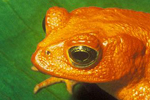Scientists have predicted for decades that climate change could have a grave impact on life on Earth, which is already facing numerous threats from habitat loss, over-exploitation, pollution, invasive species, and other impacts. However, empirical proof of extinctions–and even endangerment–due to climate change have been difficult to come by. A new study in the Proceeding of the National Academy of Science has found that by the time today’s infants are 90 years old (i.e. the year 2100) climate change could have pushed over 11 percent of the world’s species to extinction.
“Many scientists argue that we are entering the sixth great mass extinction and that anthropogenic climate change is one of
the major threats to global biodiversity,” the researchers state.
Scouring recent studies, Ilya Maclean and Robert Wilson with the Center for Ecology and Conservation at the University of Exeter, found widespread evidence of over a hundred ways in which climate change is already impacting species, including rising temperatures, changes in rainfall, and decreased sea ice. They also noted a number of predicted, but not yet observed, ways in which scientists expect climate change to impact species.
“The responses included documented changes to extinction risk, population size, and geographic range size for 305 taxa from all major groups of
organisms, covering a high proportion of the global terrestrial and marine surface,” the scientists write, adding that vertebrate species appear more threatened by climate change than plants and invertebrates.
However, the scientists admit there are big gaps in research to date.
“More studies on effects such as changes in oceanic circulation patterns and acidity on marine
organisms would improve estimates of extinction risk,” they write. Species in the tropics, such as rainforest wildlife, and insects in general are also neglected in terms of the impact of climate change. The expected impact of climate change on the world’s species could shift with more research.
“There are many unknowns when projecting declines in biodiversity,
and the values here should be interpreted with caution,” the researcher write, however they add that their data took into account a number of possible biases. Given the fact that climate change will impact species already under pressure from a number of other large-scale threats, the researchers say their estimate, if anything, is conservative.
But if their model is accurate, human-caused climate change could become responsible for hundreds-of-thousands if not millions of species vanishing from the Earth. Currently, around 2 million species have been described by scientists since the 18th Century, however no one knows just how many species call our planet their home. Estimates range from 5 million to a hundred million. Recent discoveries of wildly diverse and abundant microbe communities in the oceans could push the number even higher, possibly to a billion species.
“By looking at such a range of studies from around the world, we found that the impacts of climate change can be felt everywhere, and among all groups of animals and plants. From birds to worms to marine mammals, from high mountain ranges to jungles and to the oceans, scientists seem to have been right that climate change is a real threat to species,” Robert Wilson said in a press release adding “we need to act now to prevent threatened species from becoming extinct. This means cutting carbon emissions and protecting species from the other threats they face, such as habitat loss and pollution.”
CITATION: Ilya M. D. Maclean and Robert J. Wilson. Recent ecological responses to climate change support
predictions of high extinction risk. PNAS. www.pnas.org/cgi/doi/10.1073/pnas.1017352108.
Related articles
Ocean prognosis: mass extinction

(06/20/2011) Multiple and converging human impacts on the world’s oceans are putting marine species at risk of a mass extinction not seen for millions of years, according to a panel of oceanic experts. The bleak assessment finds that the world’s oceans are in a significantly worse state than has been widely recognized, although past reports of this nature have hardly been uplifting. The panel, organized by the International Program on the State of the Ocean (IPSO), found that overfishing, pollution, and climate change are synergistically pummeling oceanic ecosystems in ways not seen during human history. Still, the scientists believe that there is time to turn things around if society recognizes the need to change.
Over 900 species added to endangered list during past year

(06/16/2011) The past twelve months have seen 914 species added to the threatened list by the world’s authority of species endangerment, the International Union for the Conservation of Nature (IUCN)’s Red List. Over 19,000 species are now classified in one of three threatened categories, i.e. Vulnerable, Endangered, and Critically Endangered, a jump of 8,219 species since 2000. Species are added to the threatened list for a variety of reasons: for many this year was the first time they were evaluated, for others new information was discovered about their plight, and for some their situation in the wild simply deteriorated. While scientists have described nearly 2 million species, the IUCN Red List has evaluated only around 3 percent of these.
New paper stirs up controversy over how scientists estimate extinction rates

(05/19/2011) A new paper in Nature negating how scientists estimate extinction rates has struck a nerve across the scientific community. The new paper clearly states that a mass extinction crisis is underway, however it argues that due to an incorrect method of determining extinction rates the crisis isn’t as severe as has been reported. But other experts in the field contacted disagree, telling mongabay.com that the new the paper is ‘plain wrong’. In fact, a number of well-known researchers are currently drafting a response to the day-old, but controversial paper.














